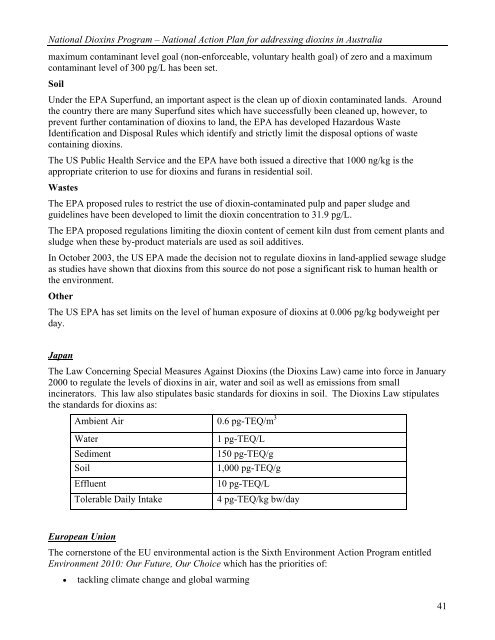National Action Plan for Addressing Dioxins in Australia
National Action Plan for Addressing Dioxins in Australia
National Action Plan for Addressing Dioxins in Australia
- No tags were found...
You also want an ePaper? Increase the reach of your titles
YUMPU automatically turns print PDFs into web optimized ePapers that Google loves.
<strong>National</strong> <strong>Diox<strong>in</strong>s</strong> Program – <strong>National</strong> <strong>Action</strong> <strong>Plan</strong> <strong>for</strong> address<strong>in</strong>g diox<strong>in</strong>s <strong>in</strong> <strong>Australia</strong>maximum contam<strong>in</strong>ant level goal (non-en<strong>for</strong>ceable, voluntary health goal) of zero and a maximumcontam<strong>in</strong>ant level of 300 pg/L has been set.SoilUnder the EPA Superfund, an important aspect is the clean up of diox<strong>in</strong> contam<strong>in</strong>ated lands. Aroundthe country there are many Superfund sites which have successfully been cleaned up, however, toprevent further contam<strong>in</strong>ation of diox<strong>in</strong>s to land, the EPA has developed Hazardous WasteIdentification and Disposal Rules which identify and strictly limit the disposal options of wasteconta<strong>in</strong><strong>in</strong>g diox<strong>in</strong>s.The US Public Health Service and the EPA have both issued a directive that 1000 ng/kg is theappropriate criterion to use <strong>for</strong> diox<strong>in</strong>s and furans <strong>in</strong> residential soil.WastesThe EPA proposed rules to restrict the use of diox<strong>in</strong>-contam<strong>in</strong>ated pulp and paper sludge andguidel<strong>in</strong>es have been developed to limit the diox<strong>in</strong> concentration to 31.9 pg/L.The EPA proposed regulations limit<strong>in</strong>g the diox<strong>in</strong> content of cement kiln dust from cement plants andsludge when these by-product materials are used as soil additives.In October 2003, the US EPA made the decision not to regulate diox<strong>in</strong>s <strong>in</strong> land-applied sewage sludgeas studies have shown that diox<strong>in</strong>s from this source do not pose a significant risk to human health orthe environment.OtherThe US EPA has set limits on the level of human exposure of diox<strong>in</strong>s at 0.006 pg/kg bodyweight perday.JapanThe Law Concern<strong>in</strong>g Special Measures Aga<strong>in</strong>st <strong>Diox<strong>in</strong>s</strong> (the <strong>Diox<strong>in</strong>s</strong> Law) came <strong>in</strong>to <strong>for</strong>ce <strong>in</strong> January2000 to regulate the levels of diox<strong>in</strong>s <strong>in</strong> air, water and soil as well as emissions from small<strong>in</strong>c<strong>in</strong>erators. This law also stipulates basic standards <strong>for</strong> diox<strong>in</strong>s <strong>in</strong> soil. The <strong>Diox<strong>in</strong>s</strong> Law stipulatesthe standards <strong>for</strong> diox<strong>in</strong>s as:Ambient Air 0.6 pg-TEQ/m 3WaterSedimentSoilEffluentTolerable Daily Intake1 pg-TEQ/L150 pg-TEQ/g1,000 pg-TEQ/g10 pg-TEQ/L4 pg-TEQ/kg bw/dayEuropean UnionThe cornerstone of the EU environmental action is the Sixth Environment <strong>Action</strong> Program entitledEnvironment 2010: Our Future, Our Choice which has the priorities of:• tackl<strong>in</strong>g climate change and global warm<strong>in</strong>g41
















